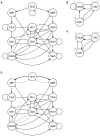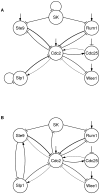Timing robustness in the budding and fission yeast cell cycles
- PMID: 20126540
- PMCID: PMC2813865
- DOI: 10.1371/journal.pone.0008906
Timing robustness in the budding and fission yeast cell cycles
Abstract
Robustness of biological models has emerged as an important principle in systems biology. Many past analyses of Boolean models update all pending changes in signals simultaneously (i.e., synchronously), making it impossible to consider robustness to variations in timing that result from noise and different environmental conditions. We checked previously published mathematical models of the cell cycles of budding and fission yeast for robustness to timing variations by constructing Boolean models and analyzing them using model-checking software for the property of speed independence. Surprisingly, the models are nearly, but not totally, speed-independent. In some cases, examination of timing problems discovered in the analysis exposes apparent inaccuracies in the model. Biologically justified revisions to the model eliminate the timing problems. Furthermore, in silico random mutations in the regulatory interactions of a speed-independent Boolean model are shown to be unlikely to preserve speed independence, even in models that are otherwise functional, providing evidence for selection pressure to maintain timing robustness. Multiple cell cycle models exhibit strong robustness to timing variation, apparently due to evolutionary pressure. Thus, timing robustness can be a basis for generating testable hypotheses and can focus attention on aspects of a model that may need refinement.
Conflict of interest statement
Figures


Similar articles
-
Cell cycle molecules and mechanisms of the budding and fission yeasts.Methods Mol Biol. 2005;296:3-29. doi: 10.1385/1-59259-857-9:003. Methods Mol Biol. 2005. PMID: 15576924 Review.
-
Dissecting the fission yeast regulatory network reveals phase-specific control elements of its cell cycle.BMC Syst Biol. 2009 Sep 16;3:93. doi: 10.1186/1752-0509-3-93. BMC Syst Biol. 2009. PMID: 19758441 Free PMC article.
-
A checkpoints capturing timing-robust Boolean model of the budding yeast cell cycle regulatory network.BMC Syst Biol. 2012 Sep 28;6:129. doi: 10.1186/1752-0509-6-129. BMC Syst Biol. 2012. PMID: 23017186 Free PMC article.
-
Neutral space analysis for a Boolean network model of the fission yeast cell cycle network.Biol Res. 2014 Nov 25;47(1):64. doi: 10.1186/0717-6287-47-64. Biol Res. 2014. PMID: 25723815 Free PMC article.
-
Robustness analysis of cellular systems using the genetic tug-of-war method.Mol Biosyst. 2012 Oct;8(10):2513-22. doi: 10.1039/c2mb25100k. Mol Biosyst. 2012. PMID: 22722869 Review.
Cited by
-
Random Parametric Perturbations of Gene Regulatory Circuit Uncover State Transitions in Cell Cycle.iScience. 2020 Jun 26;23(6):101150. doi: 10.1016/j.isci.2020.101150. Epub 2020 May 11. iScience. 2020. PMID: 32450514 Free PMC article.
-
Boolean Models of Biological Processes Explain Cascade-Like Behavior.Sci Rep. 2016 Jan 29;7:20067. doi: 10.1038/srep20067. Sci Rep. 2016. PMID: 26821940 Free PMC article.
-
Hard-wired heterogeneity in blood stem cells revealed using a dynamic regulatory network model.Bioinformatics. 2013 Jul 1;29(13):i80-8. doi: 10.1093/bioinformatics/btt243. Bioinformatics. 2013. PMID: 23813012 Free PMC article.
-
Advances and challenges in logical modeling of cell cycle regulation: perspective for multi-scale, integrative yeast cell models.FEMS Yeast Res. 2017 Jan;17(1):fow103. doi: 10.1093/femsyr/fow103. Epub 2016 Dec 18. FEMS Yeast Res. 2017. PMID: 27993914 Free PMC article. Review.
-
Boolean genetic network model for the control of C. elegans early embryonic cell cycles.Biomed Eng Online. 2013;12 Suppl 1(Suppl 1):S1. doi: 10.1186/1475-925X-12-S1-S1. Epub 2013 Dec 9. Biomed Eng Online. 2013. PMID: 24564942 Free PMC article.
References
-
- Kauffman S. Metabolic stability and epigenesis in randomly constructed genetic nets. J Theor Biol. 1969;22:437–67. - PubMed
-
- Fisher J, Henzinger T, Mateescu M, Piterman N. Bounded Asynchrony: Concurrency for Modeling Cell-Cell Interactions. Lecture Notes in Computer Science. 2008;5054:17.
-
- Alur R, Dill D. A theory of timed automata. Theoretical Computer Science. 1994;126:183–235.
-
- Faure A, Naldi A, Chaouiya C, Thieffry D. Dynamical analysis of a generic Boolean model for the control of the mammalian cell cycle. Bioinformatics. 2006;22 - PubMed
Publication types
MeSH terms
Substances
LinkOut - more resources
Full Text Sources
Molecular Biology Databases
Miscellaneous

